Pepper-box
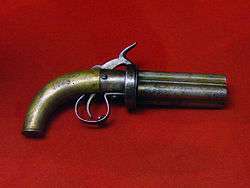
The pepper-box revolver or simply pepperbox (also "pepper-pot", from its resemblance to the household pepper shakers) is a multiple-barrel repeating firearm that has three or more barrels which revolve around a central axis. It mostly appears in the form of a multi-shot handheld firearm. Pepperboxes exist in all ammunition systems: matchlock, wheellock, flintlock, caplock, pinfire, rimfire and centerfire. While pepperboxes are usually handguns, a few rifle-sized guns were made: Samuel Colt owned a revolving 3-barrel matchlock musket from India,[1] and an 8-barrelled pepperbox shotgun was designed; but never went into production.
Pepper-boxes should not be confused with other multi-barreled type firearms with fixed barrels, or volley guns which fire all the barrels simultaneously.
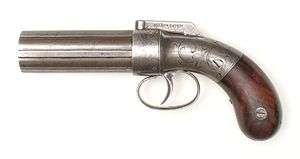
Early years
This type of firearm was popular in North America from 1830 until the American Civil War, but the concept was introduced much earlier. In the 15th century, several single-shot barrels were attached to a stock, being fired individually by means of a match.
Around 1790, pepperboxes were built on the basis of flintlock systems, notably by Nock in England and "Segallas" in Belgium. These weapons, building on the success of the earlier two-barrel turnover pistols, were fitted with three, four or seven barrels. These early pepperboxes were hand-rotated. [2]
The invention of the percussion cap building on the percussion powder innovations of the Rev. Alexander Forsyth's patent of 1807 (which ran until 1821), and the industrial revolution allowed pepperbox revolvers to be mass-produced, making them more affordable than the early handmade guns previously only seen in the hands of the rich. Examples of these early weapons are the English Budding (probably the first English percussion pepperbox), the Swedish Engholm and the American three-barrel Manhattan pistol. Most percussion pepperboxes have a circular flange around the rear of the cylinder to prevent the capped nipples being accidentally fired if the gun were to be knocked while in a pocket, or dropped, and to protect the eyes from cap fragments.
Popularity

.jpg)

The pepperbox, at least the firearm that is mostly associated with this term, was invented in the 1830s and was intended for civilian use, but military officers often made private purchases for their own use.[3] The design spread rapidly in the United Kingdom, the United States and some parts of continental Europe. It was similar to the later revolver in that it contained bullets in separate chambers in a rotating cylinder. Unlike the revolver, however, each chamber had its own barrel, making a complex indexing system unnecessary (though pepperboxes with such a system do exist).[4] Originally these pistols were muzzle loaders, but in 1837 the Belgian gunsmith Mariette invented a hammerless pepperbox with a ring trigger and turn-off barrels that could be unscrewed.[5]
A few percussion pepperboxes were still hand-rotated but most have a mechanism that rotates the barrel group as the hammer is cocked for each shot.[6] Single-action versions were made, notably by Darling of Massachusetts, but the vast majority use the self-cocking system whereby squeezing the trigger rotates the barrel block, cocks the hammer and finally fires the weapon. (Sometimes called "double action", although this term is more properly used for later revolvers that can be fired either in single-action or in self-cocking mode.) The main producer of self-cocking top-hammer pepperboxes (mostly referred to as "bar-hammer pepperbox") in the United States was Ethan Allen, but this type of weapon was also produced in very large quantities in England.[7]
Some pepperboxes fired the lower barrel instead of the upper, such as the Belgian Marriette (in configurations with between 4 and 24 barrels), the American Blunt & Syms or the English Cooper. Usually these employed an "underhammer" action, with the hammer mounted under the frame, behind the barrels, forward of the trigger (often a ring-trigger). Several other types of firing mechanisms exist, such as rotating internal firing pins (Rigby, Robbins and Lawrence, Comblain), rotating firing pins on a hammer (Sharps, Grunbaum)[8] or multiple firing pins (Martin). During the early 1830s, English gunsmith Joseph Manton offered a variant with a retractable knife blade, and pistols with up to 18 barrels.[9] The Robbins & Lawrence pepperboxes of 1851-54 had rifled barrels, an early safety catch, and a break action breechloading mechanism, meaning that it was not necessary to disassemble the gun to reload it.[7][10]
The flaw with the pepperbox is that it becomes more front-heavy if the length and number of barrels is increased, making accurate aiming difficult. With most types, in particular those with rotating barrel-clusters, it is almost impossible to aim beyond close range because the hammer is in the line of sight (some pepperboxes have a slot in the hammer through which one is supposed to aim), there is no place to put a frontsight (putting one for each barrel would only increase the weight of the front end and likely make drawing the weapon awkward), and the gun is too front-heavy to permit quick and steady aiming. However, the primary market was for civilian self-defense, so its most common use was at close range. Common practice at the time, indeed, was not to aim pistols, but instead to "shoot from the hip," holding the gun low and simply pointing at the target's center of mass. Gunfights often happened at point-blank range. With this use in mind, many pepperboxes, in fact, have smooth-bored barrels, even though rifling had been commonly used for decades by the time of their manufacture. In the Old West, large pepperboxes were favored by the gold prospectors of 49, for protection against robbers, hostile Red Indians, and rival claimants.[11][12] Both British and American made pepperboxes were also popular among gold miners in Australia as a cheaper alternative to the Colt Navy, and several were used at the Eureka Stockade.[13]
Multi-shot percussion firearms were often considered dangerous because firing one powder charge could ignite the others (a "chainfire"), all at the same time, when proper care was not taken. This problem was largely eliminated by the introduction of nipple partitions, evident on later percussion revolvers, which largely shielded the percussion caps on neighbouring chambers from the flash struck by the weapon's hammer during firing. However this feature is rarely seen on pepperboxes, although some had the nipples placed in recesses or at right angles to each other to reduce the chance of a chainfire. A chainfire in a pepperbox would be far less dangerous than in a single-barreled revolver because with a pepperbox, each of its bullets could freely exit its own dedicated barrel (essentially turning it into an impromptu volley gun). Similarly if a chamber wasn’t in exactly the right position when the hammer hit the cap it would fire normally and safely, as opposed to a single-barrelled revolver where a cylinder misaligned with the barrel when fired could cause a potentially explosive malfunction.[14] This simplicity and safety helped the pepperbox survive after more modern revolvers came along, as well as keeping production costs a lot lower than revolvers with their more complex mechanisms.
Transitional revolver

A development from the pepperbox is the so-called "transitional" revolver. This weapon uses the same action but with one single barrel attached to the front of a cut-down pepperbox cylinder. A transitional revolver is defined as a revolver (with barrel and cylinder) that does not have a cylinder-stop, an early example being the Collier flintlock revolver of 1819.[15]


It retained the pepperbox's caplock action but still had many deficiencies. The lack of an effective cylinder stop allowed a charge to be fired when the cylinder wasn’t aligned with the barrel, resulting in an erratic shot possibly damaging the gun and even injuring the firer. While the shortened cylinder made loading easier the barrel was attached to the cylinder pin; over time this weakened the gun, decreasing its accuracy. In addition it lacked partitions between its nipples, risking similar chain-fires to the earlier pepperbox. This was exacerbated by the fact that the bar-hammers common on pepperboxes and transitional revolvers usually provided a weak blow, which meant that extra-sensitive percussion caps were needed to ensure that the gun would fire, further increasing the risk of a chain-fire.[16] Although later models were fitted with a shield to protect the user from cap fragments there was still a risk of being maimed or killed as a multiple discharge could cause the gun to explode.[17]
Since the bullets didn't have to be rammed down from the muzzle but were loaded into the cylinder behind the barrel, they could be slightly larger than the bore, which facilitated the use of rifled barrels. Whereas most pepperboxes are smooth-bore, most transitionals are rifled.
Daniel Leavitt was the subject of a famous lawsuit after producing a transitional revolver in 1851 with an identical loading lever to the Colt Dragoon.[18] Guns of this type saw use in the Mexican War as an alternative to the Colt Walker and Dragoon, most notably by General Winfield Scott.[19] A late example, the 1855 Butterfield revolver, used a Maynard tape primer rather than percussion caps. 640 were issued to the US army during the American Civil War, but the government canceled any further purchases when the pistols were found to be inferior to the cheaper Colt Navy.[20] Pepperboxes and transitional revolvers started disappearing gradually in the 1850s with the manufacture of true revolvers by Samuel Colt, Webley, Robert Adams, Smith & Wesson, Jacob Rupertus and others.
Revival
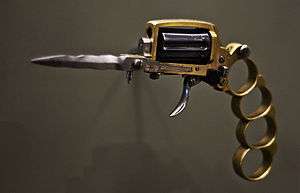
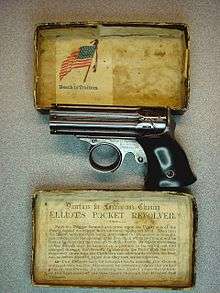
The pepperbox experienced a kind of "revival" in the late 19th century as a short, easily concealable pocket pistol that used pinfire cartridges. The five-barrel Feilitzenre pistol was almost accepted as the standard officer sidearm for the Swedish Army.
A special variation of this kind of handgun, in which the shortness of the barrel cluster was fully utilized, is the French Apache revolver. This weapon, allegedly popular among Paris street gangs, was fitted with a folding blade and knuckle-duster.[21] The pepperboxes from this period disappeared with the demise of the pinfire cartridge.
One of the more interesting pepper-box revolvers is the .22 Short, six barrel Remington Zig-Zag Derringer.[22] Unlike the older single action designs, it had a double action ring trigger and can fire six shots as fast as you can pull the trigger.[23] Guns of this type were prized by gamblers, in addition to the four barrel Christian Sharps derringer, because they could be easily concealed in a vest pocket and easily used for self-defense.[24]
Modern use
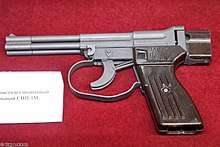
The pepperbox design was used for a small number of weapon designs in the 20th century, most notably a six-barrelled derringer in .22 caliber from Cobray.[25][26]
During the 1960s an eight-barrelled pepperbox shotgun, the Colt Defender Mark I, was designed by Robert Hillberg; but never went into production.
In the 1970s Heckler & Koch produced the five-barrelled P11 pistol designed as a covert underwater firearm firing 7.62 X 36mm darts electrically.
The Osa is a Russian four-barrelled pistol designed to fire a range of non-lethal and flare rounds from electrically-fired 18×45 mm cartridges.
The Reprringer is a design for a five-barrelled 3D printed pepperbox handgun in .22 LR, which received widespread media coverage.[27][28][29][30]
See also
References
- ↑ Cooper, C, Samuel Colt: Arms, Art, and Invention (2006) p.26
- ↑ The New Weapons of the World Encyclopedia: An International Encyclopedia from 5000 B.C. to the 21st Century By Diagram Group, (Macmillan, 2007) p.126
- ↑ Kinard, Jeff (2004). Pistols: An Illustrated History of Their Impact. ABC-CLIO. pp. 61–62. ISBN 978-1-85109-470-7.
- ↑ Dunlap, Jack (1964). American, British & Continental Pepperbox Firearms. San Francisco: Sunset Press. p. 11. ISBN 0870151584.
- ↑ Pistols an illustrated history
- ↑ Gunsmoke and saddle leather
- 1 2 Chapel, Charles Edward (19 September 2013). Guns of the Old West: An Illustrated Guide. Courier Dover Publications. p. 88. ISBN 978-0-486-42161-2.
- ↑ Sharps pepper-box pistol 1859–1874
- ↑ Pistols an illustrated history
- ↑ Antique firearms
- ↑ Firearms laws and the 2nd amendment
- ↑ 49ers pepperbox
- ↑ The Eureka Stockade
- ↑ Pistols an illustrated history
- ↑ Howard RIcketts, Firearms (London, 1962)
- ↑ "Pistols". Retrieved 13 February 2016.
- ↑ .Jeff Kinard (2004). Pistols: An Illustrated History of Their Impact p.65.
- ↑ The Guns that Won the West: Firearms on the American Frontier, 1848–1898, John Walter, MBI Publishing Company, 2006, ISBN 1-85367-692-6
- ↑ Pistols with pedigrees
- ↑ "Civil War Revolvers". Retrieved 13 February 2016.
- ↑ Hell In A Handbasket
- ↑ "Guns of the Old West". Retrieved 13 February 2016.
- ↑ "Flayderman's Guide to Antique American Firearms and Their Values". Retrieved 13 February 2016.
- ↑ Guns of the Old West
- ↑ Aera 1
- ↑ Cobray pepperbox video
- ↑ 5 Different 3D Printed Gun Models Have Been Fired Since May, 2013 – Here They Are, 3D Print, September 10, 2014. (archive)
- ↑ Introducing the 3D-printed Reprringer Pepperbox (VIDEO), guns.com, September 13, 2013. (archive)
- ↑ 3D Printed Pepperbox Pistol, firearmblog, October 8, 2013. (archive)
- ↑ 3D printed guns a year on: from prototype to serious weapons, Wired, 16 May 2014. (archive)
External links
| Wikimedia Commons has media related to Pepper-box. |